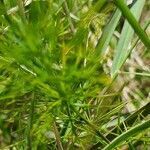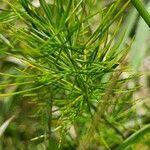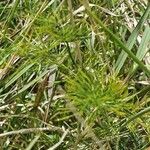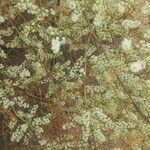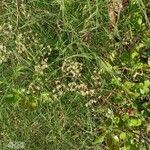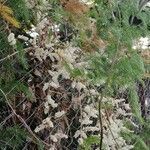Tall climbers or, if without support, tangled shrubs with shiny yellow stems and soft, feathery branches when 'in leaf, usually bare when in flower. Rhizome woody, small, compact. Roots many, with fusiform swellings near rhizome. Stems straight, smooth. Spines short, recurved, present on stems and main branches. Branches spreading, bearing numerous branchlets, ±70 mm long, closely beset with overlapping cladode fascicles. Cladodes ±4-8 per fascicle, unequally long, filiform, 10-16 mm long, thin. Flowers in simple racemes, in multibudded axils of stems and branches, usually several racemes together, racemes ±20-30 mm long; tepals attenuate below, ±3 mm long, white with a reddish central streak, reflexed in fruit; bracts membranous, acuminate, curved around stalk below; stalk ±2 mm long, articulated in middle. Stamens with red (or dark) anthers. Ovary attenuate below. Berry shortly stipitate, ±7 mm in diameter, red.
Climbing shrub to 7 m high; branches terete, lined or angled, glabrous with spines 2– 3 mm long in young parts to 5– 8 mm long in older parts.. Cladodes in fascicles of 2– 6, subulate to flattened, 8– 35(– 40)× 0.5– 0.7 mm.. Inflorescence racemose, 1.5– 19 cm long, glabrous; racemes solitary or fascicled, branching; the terminal parts of racemes with umbellate fascicles of 4– 6 flowers; bracts ovate, concave, 1.5– 4 mm long, glabrous, membranous, sometimes falling quickly; pedicel 4– 8 mm long (elongating to 10 mm long in fruit), articulated at the middle or below.. Tepals greenish white to white, 2.5– 3 mm long; stamens shorter than the perianth parts with anthers orange to red; ovary obovate, 3-locular with 6– 7 ovules in each locule; style 1– 1.25 mm long with 3-branched stigma.. Berry green turning red at maturity, 8– 10(– 13) mm in diameter, commonly 1-seeded, sometimes 2– 3-seeded.
Climber with stems to c. 4 m long. Roots fibrous and tuberous. Cladodes (2) 3–6 per axil, acicular to filiform, apiculate, 10–30 mm long, to 1 mm wide, glabrous. Scale leaves spine-like, 2–4 mm long (on older stems axillary spines to 12 mm long reported by Harden et al. 2007). Inflorescence a raceme, sometimes paired, to 10 cm long; pedicels 2–4 mm long, articulated 1–2 mm from base. Flowers single or paired (in axillary racemes to 10 cm long according to Harden et al. 2007), bisexual, 4–6 mm diam., white. Sepals and petals 2.5–3 mm long, c. 1 mm wide. Stamens 2–3 mm long; filaments 1.5–2.5 mm long; anthers 0.3–0.5 mm long, orange. Ovary ovoid, 2–2.5 mm long; style 0.5–1 mm long, minutely trifid. Berry ±globular, (3–) 5–6 mm diam., red. Seed 1, 3–4 mm diam.
Climber or tangled shrub, up to 4 m high. Stems straight, smooth, shiny yellow, with spreading branches; young stems purple. Spines short, recurved, present on stems and main branches. Cladodes 4-8 in overlapping fascicles, filiform, thin, 10-16 mm long. Flowers in simple racemes in axils of stems and branches; stamens with red or dark anthers; pedicels ± 2 mm long, articulated below middle. Flowering time Nov.-Apr. Fruit a red berry.
A creeping or climbing herb or shrub. It has woody stems. It grows 2 m high. It spreads 2 m wide. The stems are slender and trailing. The leaves are light green and narrow. They are 5 cm long. The flowers are very small. The fruit are small round red berries.
Tall climber or tangled shrub. Spines spreading-recurved, ± 5 mm long at base of plant. Racemes simple. Anthers red. Berry rounded at base. Flowers white with a reddish central streak.
Climbing plant up to 6 ft. high
Flowers green or white
Berries red.
